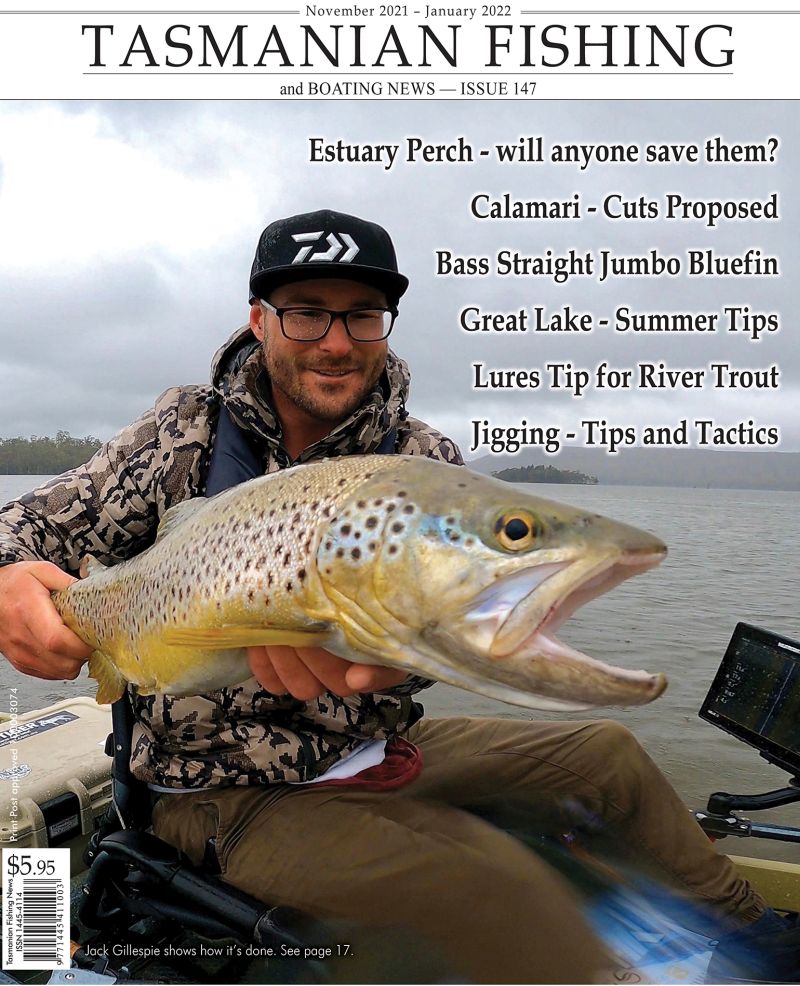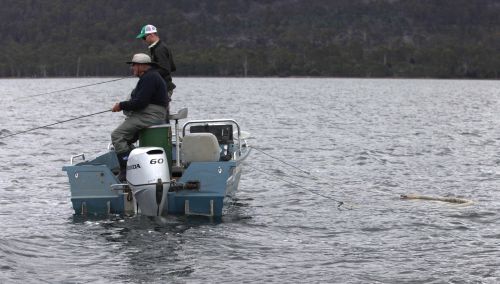From the Archives ...
Atlantic Salmon At Large
Atlantic Salmon At Large
Recently Atlantic salmon seems to be a very hot topic amongst local anglers, especially those in the south of the state in the D'Entrecasteaux area. Northern anglers should take a close look at the Tamar as there are opportunities here as well.
The recent "great escape" has provided a perfect opportunity for fresh and saltwater anglers alike to experience some truly memorable sport. Tasmania's pristine, clean and cool waters are the perfect nursery for the Atlantic Salmon and as our local fish farms produce more and more fresh quality seafood it is a fact that there are going to be tangible consequences.
Please check all relevant authorities before fishing - www.ifs.tas.gov.au and dpipwe.tas.gov.au . Don't forget issuu.com/stevenspublishing for years of back issues !
Trout in the waves at Great Lake
Polaroiding on the Great Lake Jim Allen explains his technique polaroiding trout in the waves of Great Lake.
The requirements of polaroiding on the Great Lakes are a big northerly wind and a blue sky. Quite often in the warmer northerlies a lot of terrestrial insects get blown onto the water - particularly after Christmas. When you get the beetles on the water the fish get up in the waves.
- Category: Great Lake
- Hits: 5681
Two boys, a dream, a boat and a fish
by Andrew Hart
A dream - Marlin are the king of all fish. They have captured the imagination of people for generations. They are for many, a dream, but for two Tasmanian teenagers, that dream has become a reality.
- Category: Tuna Fishing and other Game Fishing
- Hits: 5352
Trouting as winter approaches
Greg French takes a look at the trout fishing opportunities as the season comes to a close.
The Lakes
The most significant thing about the trout fishing in April is that the brown trout at many highland waters are well and truly geared up for spawning. In March there may well have been males gathering in bays fed by major spawning streams, but by now plenty of females will have coloured-up and there should be intense congregations of both sexes.
- Category: Trout Fishing
- Hits: 7353
Squid great to eat great for bait
Phil Ellerton takes a look at a member of the Cephalopod family - the squid.
Tasmania has two main squid - calamari and arrowhead. The tubes of both of these are excellent fare when eaten fresh, while the tentacles can be frozen for bait. As bait there is little better to entice many saltwater species.
- Category: Saltwater and Estuary Fishing
- Hits: 10845
Its time to hit the surf
Ron McBain takes a look at Surf fishing.
Because Tasmania has many excellent surf fishing beaches that are easily accessible; it is no surprise that this form of angling is one of the fastest growing. It doesn't have to be expensive and it's a form of fishing that can involve the whole family.
- Category: Saltwater and Estuary Fishing
- Hits: 8422
Harts Hints - Handling the Catch
by Andrew Hart
You've don't it! You've landed what you were after and a good size fish it is too! Finally, you can take home something for the table. You can't wait to show off your catch and then enjoy a tasty and nutritious meal. You've done the hard work! Or have you?
- Category: Tackle, Boats and other Equipment
- Hits: 5475
Pump your own bait
Michael Bok tells where, how and why.
At times gathering bait is almost as much fun as fishing itself and the rewards from catching better fish on fresh caught bait are great. A bait pump is a great help if you fish out coastal or estuary environments. What is a bait pump?
- Category: Tackle, Boats and other Equipment
- Hits: 35782
Millions of minute mayflies on Lake Meadowbank
Robert Gott explains how the minute caenid mayfly and Lake Meadowbank combine to create a special fishing experience.
Some years ago it was my good fortune to fish with a very colourful Irishman. This fellow was a highly skilled practitioner at the craft and passionate about his fishing in a way that only the Irish can be. I clearly remember two things about him. He was a master fly tier and his creations, minor works of art.
- Category: Meadowbank Lake
- Hits: 10362
Boating techniques - improving your catch rate
Trout guide, Peter Hayes explains some of the techniques he uses that will help improve your catch rate.
As I stand at the door of my Great Lake shack the eleventh day of February is just four hours old. The morning is black and remarkably quiet. Around me the trees seem hypnotised by the stillness in the air. This is a rare and beautiful moment in the highlands of Tasmania and you need to rise early to witness it.
- Category: Tackle, Boats and other Equipment
- Hits: 6352
Great Lake rainbow trout in excellent condition
Despite the low lake level at Great Lake rainbow trout arrived at the Liawenee fish trap in good numbers this year.
The fish were stripped of eggs and milt for grow out of the fertilised eggs at the IFS hatchery at New Norfolk. While this has been the practise for some time, this is the first year in recent times that eggs from wild rainbow trout have been treated at Liawenee to produce triploid fish.
Once fertilised, the eggs are treated in a pressure vessel to produce offspring that are sterile (triploid) in the sense that they do not produce gonads (sex organs). The consequence of this process is that the fish do not stop feeding in winter and do not put any energy into reproduction. The end result that the fish have the potential to grow larger in a shorter amount of time.
- Category: Great Lake
- Hits: 9591
Subcategories
Current TFBN
Click above for current issue content. The current issue of TFBN is extensive and topical. In Tackle Stores, Newsagents and by subscription.
Delivered to your door for $48 for 2 years (8 issues). To subscribe, send Mike $48 via www.paypal.com.au . (Basic instructions are here) The email is at Contact Us. Your address will be included from PayPal.
Or phone Mike with your c/c handy on 0418129949
Please ensure your details are correct, for Mike to organise delivery.
TFBN Newsletter Sign up Form
Why not submit an article ?
When you have finished for the day, why not have a brag about the ones that didn't get away! Send Mike an article on your fishing (Click here for contact details), and we'll get it published here. Have fun fishing - tasfish.com
Category Descriptions
Here is a list of all of the Article Categories. The number in Brackets, eg (13) is the number of articles. Click on Derwent River and all articles relating to the Derwent will be displayed in the central area.
Articles by Category
-
Rivers (3)
-
Saltwater and Estuary Fishing (149)
-
Kayak Fishing (34)
-
Lakes (1)
-
Great Lake (62)
-
Lake Leake (52)
-
Woods Lake (16)
-
Lake Augusta (11)
-
Huntsman Lake (13)
-
Lake Pedder and Gordon (10)
-
Lake Dulverton (5)
-
Lake Crescent (6)
-
Tooms Lake (10)
-
Lake Mackintosh (2)
-
Lake Barrington (5)
-
Little Lake (8)
-
Meadowbank Lake (5)
-
Lake King William (7)
-
Lake St Clair (2)
-
Western Lakes (12)
-
Arthurs Lake (35)
-
Lake Echo (7)
-
Four Springs (54)
-
Lake Sorell (7)
-
Lake Burbury (6)
-
Other Lakes (57)
-
Brushy Lagoon (18)
-
Little Pine Lagoon (5)
-
Penstock Lagoon (16)
-
Brumbys Creek (7)
-
-
Events (48)
-
Estuary Fishing (0)
-
Coastal Catches (46)
-
Super Trawler (46)
-
IFS, DPIPWE, MAST and Peak Bodies (435)
-
Commercial Interests (98)
-
Other (24)
-
TFBN Back Issues (8)
-
Fly Fishing (67)
-
Trout Fishing (252)
-
Meteorology and Weather (8)
-
Jan’s Flies (50)
-
Tuna Fishing and other Game Fishing (86)
-
Cooking Fish (19)
-
Fishing Information (1)
-
Fishing Books (8)
-
Videos (5)
-
Tackle, Boats and other Equipment (146)
-
World Fly Fishing Championship 2019 (2)
Popular Tags
windyty.com
Visit https://www.windyty.com/
Rubicon Web and Technology Training
Hello everyone, I thought it would be a good time to introduce myself.
My name is Stephen Smith and I have been managing the website tasfish.com since May 2009.
It has been an epic journey of learning and discovery and I am indebted to Mike Stevens for his help, support and patience.
I am developing a new venture Rubicon Web and Technology Training ( www.rwtt.com.au ). The focus is two part, to develop websites for individuals and small business and to train people to effectively use technology in their everyday lives.
Please contact me via www.rwtt.com.au/contact-me/ for further information - Stephen Smith.
From the Archives ... (last chance)
Sea Run Trout
Mid Sea-Run Season Report
Sea-run trout fishing this year got off to a cracking start in most areas, with the majority of anglers employing nearly every trout fishing technique to secure fish in local estuaries statewide.
Even those anglers fishing the "off-season" lower down in our estuaries for sea-trout commented on the number of fish moving in early August.



